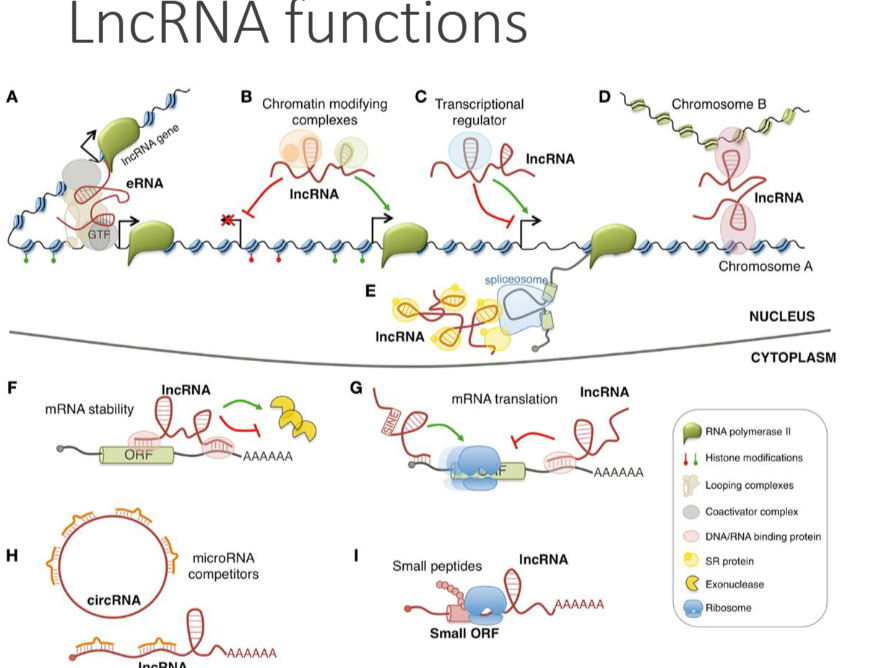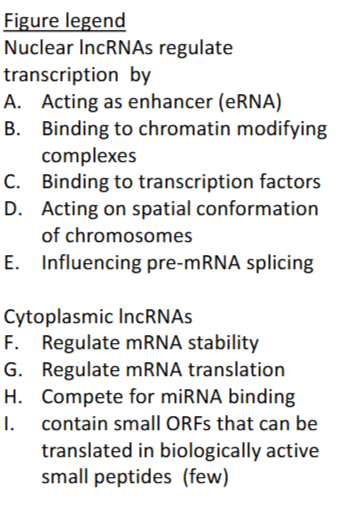Gene regulation (1) Flashcards
What does the central dogma state about DNA and mRNA content in cells?
DNA content is the same; mRNA content differs.
What methods are used to study DNA content?
Southern Blot, PCR, DNA sequencing, ChIP.
What is the purpose of Western Blotting?
To study protein content in different cell types.
What role do proteins play in phenotype production?
Proteins produce phenotype, e.g., globin transports oxygen.
What is the starting material for Western Blotting?
Biological sample, e.g., tissue or cells.
How does cell signaling mainly occur?
Through kinases phosphorylating other proteins.
What is RT-PCR used for?
RNA extraction and cDNA synthesis.
What does qRT-PCR measure?
<p>Signal after each cycle to quantify RNA.</p>
<p>More RNA initially present will show higher fluoresnce in an earlier cycle- will reach Ct value in fewer cycles</p>
How is DNA content assessed?
Single gene level or globally, e.g., Southern Blotting.
Method for protein separation in Western Blotting
<p>Western blotting is a technique used to detect specific proteins in a sample. It involves separating proteins by size using SDS-PAGE, transferring them onto a membrane, and then using antibodies to identify the target protein. This process allows for visualization and analysis of protein expression.</p>
<p></p>
<p> steps in Western Blotting process</p>
<p>Protein extraction and quantification</p>
<p>Separation</p>
<p>Electrophoretic Transfer Staining and Detection Visualisation and Quantification</p>
<p>Staining, detection, visualization, and quantification </p>
<img></img>
<p>how is a southern blot done</p>
<ol><li><p><strong>DNA Extraction and Digestion</strong>: Extract DNA from cells and cut it into smaller fragments using restriction endonucleases.</p></li><li><p><strong>Gel Electrophoresis</strong>: Separate these fragments by size using agarose gel electrophoresis.</p></li><li><p><strong>Denaturation and Transfer</strong>: Denature the DNA (make it single-stranded) and transfer it onto a nitrocellulose or nylon membrane.</p></li><li><p><strong>Hybridization</strong>: Add a radiolabeled or fluorescent probe that binds to the DNA sequence of interest.</p></li><li><p><strong>Detection</strong>: Visualize the probe-bound DNA fragments to determine the presence and structure of the gene based on the pattern of hybridization.</p></li></ol>
What is the DNA content comparison between different cell types?
DNA content is relatively the same.
What are the exceptions where DNA content may differ?
<p>DNA loss, amplification, rearrangement, whole plants can grow from plant grafts, nuclear transplantation of somatic to egg cell can result in development of whole new organism</p>
<p>What are the two potential mechanisms for different gene expression</p>
Transcriptional and post-transcriptional control.
What evidence supports transcriptional control?
Polytene chromosomes and DNA puffs.
How is transcriptional regulation achieved?
<p>By altering chromatin structure or binding of transcription factors</p>
<p></p>
What roles do regulatory RNAs play?
Control gene expression at transcriptional levels.
How do small ncRNAs inhibit gene expression?
<p>Promote mRNA degradation, block translation, inhibiting transcription by re - organization of target gene into inactive chromatin</p>
<p>example of DNA loss</p>
Erythrocytes extrude nuclei, losing DNA while carrying haemoglobin.
<p>What is DNA amplification example</p>
Genes encoding chorion/eggshell proteins are selectively amplified in egg-surrounding cells.
<p>What is DNA rearrangement example</p>
Genes encoding immunoglobulins can rearrange in B cells.
What is transcriptional control?
Decision on which genes are transcribed.
What is the primary level of gene regulation?
Gene regulation occurs primarily at the level of transcription.
Salivary gland cells exposed to different hormones.
Elevated temperature (heat shock) or steroid hormone (ecdysone) results in new puffs at specific sites
Each treatment produces a specific pattern of puffs. Treatment results in increased transcription of genes responsible for response to these agents
what are the main methods of transcriptional regulation
A) Regulatory proteins can access certain regions to switch on transcription
Alternatively, chromatin structure could be constitutively active – regulation at the level of transcriptional proteins when creating the primary transcript C) Most commonly, both mechanisms occur together – more open chromatin structure followed by activation of transcription by regulatory proteins.
What processes produce small ncRNA
They are processed from longer pre-cursor RNAs that are folded into hair pins.
Drosha and Dicer proteins cleave hairpins from precursor RNAs.




